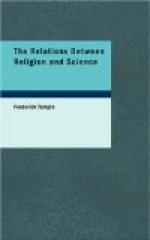by their mutual collision; made to act chemically
on one another by such increase or by subsequent decrease
of temperature; perpetually approaching nearer to
the forms into which, by the incessant action of the
same forces, the present universe has grown; these
elements, and the working of the several laws of their
own proper nature, may be enough to account scientifically
for all the phenomena that we observe. We do
not even then get back to regularity. Why these
elements, and no others; why in these precise quantities;
why so distributed in space; why endowed with these
properties: still are questions which Science
cannot answer, and there seems no reason to expect
that any scientific answer will ever be possible.
Nay, I know not whether it may not be asserted that
the impossibility of answering one at least among
these questions is capable of demonstration. For
the whole system of things, as far as we know it,
depends on the perpetual rotation of the heavenly
bodies; and without original irregularity in the distribution
of matter no motion of rotation could ever have spontaneously
arisen. And if this irregularity be thus original,
Science can give no account of it. Science, therefore,
will have to begin with assuming certain facts for
which it can never hope to account. But it may
begin by assuming that, speaking roughly, the universe
was always very much what we see it now, and that
composition and decomposition have always nearly balanced
each other, and that there have been from the beginning
the same sun and moon and planets and stars in the
sky, the same animals on the earth and in the seas,
the same vegetation, the same minerals; and that though
there have been incessant changes, and possibly all
these changes in one general direction, yet these changes
have never amounted to what would furnish a scientific
explanation of the forms which matter has assumed.
Or, on the other hand, Science may assert the
possibility of going back to a far earlier condition
of our material system; may assert that all the forms
of matter have grown up under the action of laws and
forces still at work; may take as the initial state
of our universe one or many enormous clouds of gaseous
matter, and endeavour to trace with more or less exactness
how these gradually formed themselves into what we
see. Science has lately leaned to the latter
alternative. To a believer the alternative may
be stated thus: We all distinguish between the
original creation of the material world and the history
of it ever since. And we have, nay all men have,
been accustomed to assign to the original creation
a great deal that Science is now disposed to assign
to the history. But the distinction between the
original creation and the subsequent history would
still remain, and for ever remain, although the portion
assigned to the one may be less, and that assigned
to the other larger, than was formerly supposed.
However far back Science may be able to push its beginning,
there still must lie behind that beginning the original
act of creation—creation not of matter
only, but of the various kinds of matter, and of the
laws governing all and each of those kinds, and of
the distribution of this matter in space.




